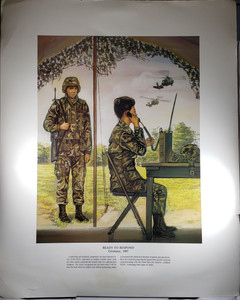
Into the Provinces - Vietnam, 1965
Technically trained sergeants and specialists built roads, schools, hospitals, and other vital installations during the early phase of the Vietnam War. These experienced, career NCOs applied their technical skills to a new purpose-civic action programs. These measures were designed to support the Saigon government's efforts to forge a modem nation capable of denying popular support to the Communist insurgents. Here the master sergeant surveys a new road under construction into a remote region of the Vietnamese countryside.
Deployment into the provinces of Vietnam called for innovation in field service uniforms. A new tropical version appeared, based on the parachute clothing of World War II. Originally perfected for counterinsurgency operations, the new clothing was issued to rotating personnel as it became available. It brought back the use of cargo pockets and other utilitarian features. Some original touches, such as shoulder loops, waist tabs, and exposed buttons, soon had to be eliminated. The uniform was accompanied by fast-drying boots with nylon uppers. The first issue of the new hot-weather boot had no ankle reinforcement or protection against punji stakes.
Headgear even cooler than the recently developed olive green baseball cap became a necessity. The latter, still worn by the heavy-equipment operator, could not block the hot rays of the Vietnamese sun. The master sergeant checking the work of the road-building crew wears an early version of the "bush hat. " At this stage of the war, troops still wore the white underwear and brightly colored name tapes and rank and other insignia more appropriate for a garrison environment.
The Poster in the picture is the one for purchase.






